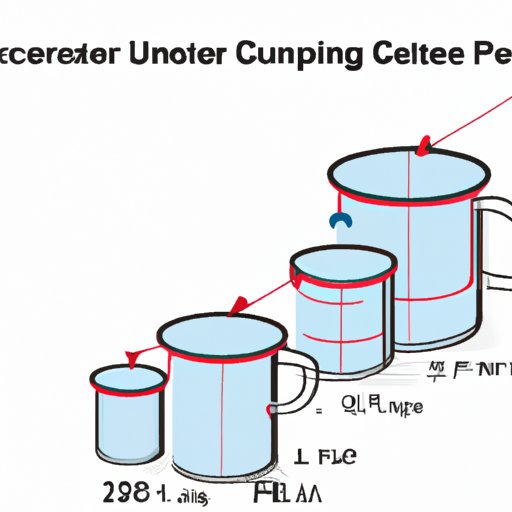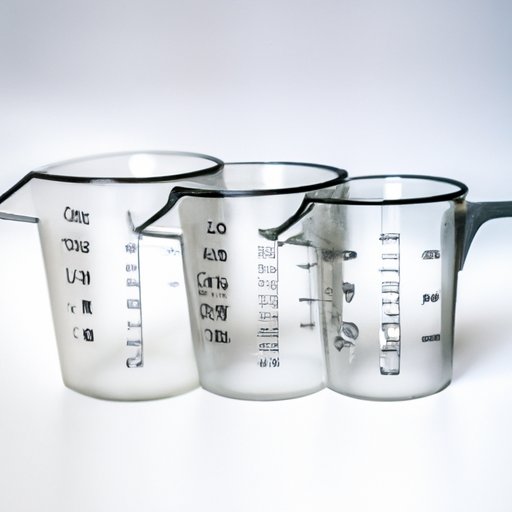Introduction
Have you ever found yourself in the middle of a recipe, only to realize that the measurement called for is in liters instead of cups? Don’t worry, you’re not alone. Converting metric measurements to imperial ones can be a confusing task, especially in the kitchen where accurate measurements are crucial to ensure delicious results. That’s why understanding how many cups are in a liter is an essential skill for any home cook or baker.

Converting Measurements: Understanding How Many Cups are in a Liter
Before we dive into converting cups to liters, let’s first take a closer look at these two units of measurement. A liter is a metric measurement of volume equal to 1000 milliliters or 33.814 fluid ounces. Meanwhile, a cup is an imperial unit of volume commonly used in the United States and equivalent to 8 fluid ounces or approximately 236 milliliters.
Converting cups to liters, or vice versa, requires a simple calculation. One liter is equal to 4.226 cups, and one cup is equal to 0.2366 liters. To convert cups to liters, simply multiply the number of cups by 0.2366. To convert liters to cups, multiply the number of liters by 4.226.
Let’s take a look at some common measurements in cups and their equivalent in liters:
| Cups | Liters |
|---|---|
| 1/4 | 0.0592 |
| 1/3 | 0.0788 |
| 1/2 | 0.1183 |
| 1 | 0.2366 |
| 2 | 0.4732 |
| 3 | 0.7098 |
| 4 | 0.9464 |
| 5 | 1.183 |
| 6 | 1.4196 |
Kitchen Tips: The Simple Equation for Converting Cups to Liters
If math isn’t your strong suit or you’re in a rush, there’s a simple equation you can use to quickly convert cups to liters. The equation is:
Liters = cups / 4.226
For example, if a recipe calls for 2 cups of milk and you need to convert that to liters, you would use the equation:
Liters = 2 / 4.226 = 0.4732 liters
Metric Measurements in the Kitchen: How to Quickly Convert Cups to Liters
In addition to the simple equation, there are other tips and tricks to quickly convert cups to liters without a calculator. One helpful tool is using measuring cups with metric markings. Many measuring cups have both imperial and metric measurements listed, making it easy to measure out the exact amount needed.
If you don’t have a measuring cup with metric markings, you can still use a regular measuring cup by looking for the 1/4, 1/3, 1/2, and 1 cup lines. Simply fill the measuring cup with the ingredient, then multiply the number of cups by 0.2366 to determine the measurement in liters.
The Ultimate Guide to Cup to Liter Conversions: How to Never Make a Measurement Mistake Again
If you’re still feeling unsure about converting cups to liters, don’t worry. The ultimate guide to metric conversions in the kitchen is here to help!
First and foremost, double-checking your conversions is crucial to ensuring accuracy. Even the most experienced cooks and bakers can make mistakes, so it’s important to always check your work. One way to do this is by using an online converter or conversion chart to confirm your calculations.
Another common mistake to avoid is confusing volume and weight measurements. Cups and liters are units of volume, while grams and ounces are units of weight. Make sure you’re using the correct type of measurement based on the ingredient being used.
From Cups to Liters: How to Use Metric Measurements in Your Kitchen
Now that you understand how to convert cups to liters and vice versa, it’s important to discuss why metric measurements are valuable in the kitchen. Unlike imperial measurements, which can vary depending on the location and language, metric measurements are standardized. This means that whether you’re in the United States or Europe, a liter will always equal 1000 milliliters.
In addition to being universally understood, metric measurements are also more precise. Imperial units rely on fractions and different conversions between ounces, cups, and pints, making it more challenging to accurately measure out ingredients.
Some common metric measurements to become familiar with in the kitchen include milliliters, grams, and kilograms. Milliliters are a unit of volume equivalent to 1/1000 of a liter, while grams and kilograms are units of weight. Understanding these and other metric measurements will make recipe conversions simpler and more accurate.
Metric Conversion Made Easy: How Many Cups in a Liter and Why It Matters
Understanding how many cups are in a liter and other metric conversions is key to successful cooking and baking. Inaccurate measurements can lead to recipes that are too dry, too moist, or lack the intended flavor. By taking the time to understand metric conversions and ensuring accuracy, you can achieve perfect results every time.
The Importance of Accurate Measurements: How to Convert Cups to Liters and Get Perfect Results Every Time
Accurate measurements are crucial to successful cooking and baking, which is why it’s important to take the time to understand how to convert cups to liters and vice versa. By using the simple equation, double-checking your conversions, and becoming familiar with metric measurements, you’ll never make a measurement mistake again.
